Advertisements
Advertisements
Questions
Obtain the condition for bridge balance in Wheatstone’s bridge.
Obtain the balancing conditions in the case of Wheatstone’s bridge.
Solution
An important application of Kirchhoff’s rules is the Wheatstone’s Bridge. It is used to compare resistances and also helps in determining the unknown resistance in an electrical network. The bridge consists of four resistances P, Q, R, and S connected. A galvanometer G is connected between the points B and D. The battery is connected between points A and C. The current through the galvanometer is IG and its resistance is G.

Wheatstone’s bridge
Applying KirchhofFs current rule to junction B,
I1 – IG – I3 = 0 ….. (1)
Applying Kirchhoff’s current rule to junction D,
I2 + IG – I4 = 0 ….. (2)
Applying Kirchhoff’s voltage rule to loop ABDA,
I1P + IGG – I2R = 0 ….. (3)
Applying Kirchhoff’s voltage rule to loop ABCDA,
I1P + I3Q – I4S – I2R = 0 ….. (4)
When the points B and D are at the same potential, the bridge is said to be balanced. As there is no potential difference between B and D, no current flows through the galvanometer (IG = 0).
Substituting IG = 0 in equation, (1), (2) and (3), we get
I1 = I3 ….. (5)
I2 = I4 ….. (6)
I1P = I2R ….. (7)
Substituting the equation (5) and (6) in equation (4)
I1P + I1Q – I2R = 0
I1(P + Q) = I2 (R + S) ….. (8)
Dividing equation (8) by equation (7), we get
`("P + Q")/"P" = ("R + S")/"R"`
`11 + "Q"/"P" = 1 + "S"/"R"`
`=> "Q"/"P" = "S"/"R"`
`"P"/"Q" = "R"/"S"` .....(9)
This is the bridge balance condition. Only under this condition, galvanometer show null deflection. Suppose we know the values of two adjacent resistances; the other two resistances can be compared. If three of the resistances are known, the value of the unknown resistance (the fourth one) can be determined.
RELATED QUESTIONS
State Kirchhoff's rules and explain on what basis they are justified.
Given the resistances of 1 Ω, 2 Ω, 3 Ω, how will be combine them to get an equivalent resistance of (6/11) Ω?
Determine the equivalent resistance of networks shown in Fig.

Determine the equivalent resistance of networks shown in Fig.
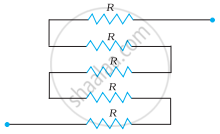
State Kirchhoff's rules for an electric network. Using Kirchhoff's rules, obtain the balance condition in terms of the resistances of four arms of Wheatstone bridge.
Using Kirchhoff’s rules determine the value of unknown resistance R in the circuit so that no current flows through 4 Ω resistance. Also find the potential difference between A and D.
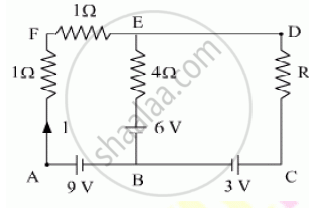
Calculate the value of the resistance R in the circuit shown in the figure so that the current in the circuit is 0.2 A. What would b the potential difference between points B and E?
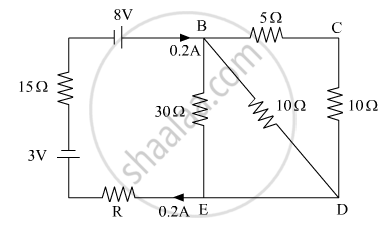
In the given circuit, assuming point A to be at zero potential, use Kirchhoff’s rules to determine the potential at point B.

Consider the following two statements:-
(A) Kirchhoff's junction law follows from conservation of charge.
(B) Kirchhoff's loop law follows from conservative nature of electric field.
Consider the circuit shown in the figure. Find (a) the current in the circuit (b) the potential drop across the 5 Ω resistor (c) the potential drop across the 10 Ω resistor (d) Answer the parts (a), (b) and (c) with reference to the figure.
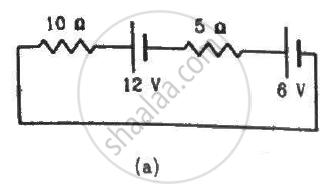
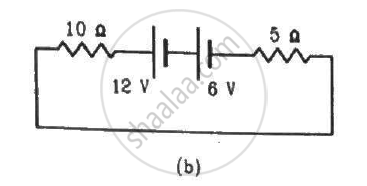
A capacitor of capacitance 8.0 μF is connected to a battery of emf 6.0 V through a resistance of 24 Ω. Find the current in the circuit (a) just after the connections are made and (b) one time constant after the connections are made.
On which conservation principle is Kirchoff's Second Law of electrical networks based?
In the circuit shown in the figure below, E1 and E2 are two cells having emfs 2 V and 3 V respectively, and negligible internal resistance. Applying Kirchhoff’s laws of electrical networks, find the values of currents l1 and I2.
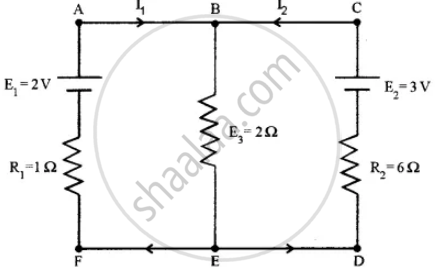
State Kirchhoff’s current rule.
Explain the determination of unknown resistance using meter bridge.
How the emf of two cells are compared using potentiometer?
A potentiometer wire has a length of 4 m and resistance of 20 Ω. It is connected in series with resistance of 2980 Ω and a cell of emf 4 V. Calculate the potential along the wire.
In a potentiometer arrangement, a cell of emf 1.25 V gives a balance point at 35 cm length of the wire. If the cell is replaced by another cell and the balance point shifts to 63 cm, what is the emf of the second cell?
Kirchhoff’s second law is a consequence of law of conservation of ______.
Figure shows current in a part of an electrical circuit. Then current I is ______.
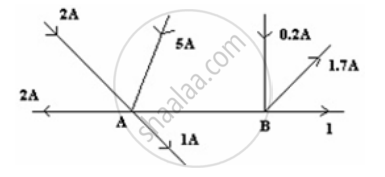
While measuring the length of the rod by vernier callipers, the reading on the main scale is 6.4 cm and the eight divisions on vernier is in line with marking on the main scale division. If the least count of callipers is 0.01 and zero error - 0.04 cm, the length of the rod is ______.
Two cell of 1.25 V and 0.75 V are connected parallel. The effective voltage will be:-
The figure below shows current in a part of electric circuit. The current I is ______.
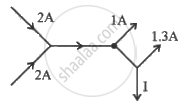
Three resistors having resistances r1, r2 and r3 are connected as shown in the given circuit. The ratio `"i"_3/"i"_1` of currents in terms of resistances used in the circuit is :
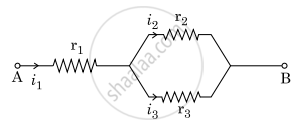
What is the advantage of using thick metallic strips to join wires in a potentiometer?
Why are alloys used for making standard resistance coils?
Two cells of voltage 10V and 2V and internal resistances 10Ω and 5Ω respectively, are connected in parallel with the positive end of 10V battery connected to negative pole of 2V battery (Figure). Find the effective voltage and effective resistance of the combination.
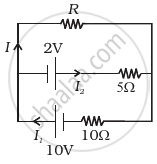
State the two Kirchhoff’s rules used in the analysis of electric circuits and explain them.
Derive the equation of the balanced state in a Wheatstone bridge using Kirchhoff’s laws.
A 6-volt battery is connected to the terminals of a three-metre-long wire of uniform thickness and resistance of 100 ohms. The difference of potential between two points on the wire separated by a distance of 50 cm will be ______.
The figure below shows two batteries, E1 and E2, having emfs of 18V and 10V and internal resistances of 1 Ω and 2 Ω, respectively. W1, W2 and W3 are uniform metallic wires AC, FD and BE having resistances of 8 Ω, 6 Ω and 10 Ω respectively. B and E are midpoints of the wires W1 and W2. Using Kirchhoff's laws of electrical circuits, calculate the current flowing in the wire W3:

